Commercial Waffle Maker Guide
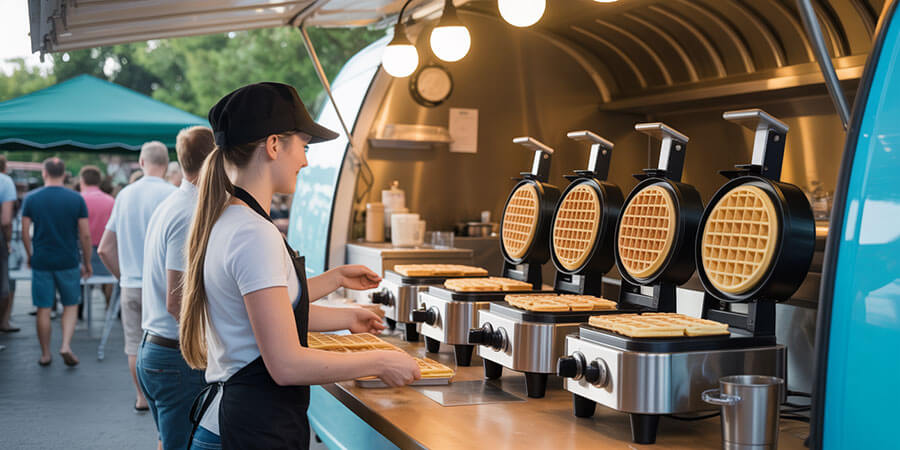
Everything you need to know about choosing commercial waffle makers for your business
Perfect Waffles Start Here
The Business Case for Commercial Waffle Equipment
Waffles represent a unique opportunity in the competitive breakfast and dessert market. Their combination of crisp exterior and soft interior creates an irresistible texture that customers love, while their versatility allows for endless customization with toppings, fruits, and sauces.
Commercial waffle makers go beyond simple cooking appliances - they become the centerpiece of your breakfast or dessert service. Modern units feature precise temperature control, consistent cooking times, and the durability needed for high-volume restaurant operations.
Revenue Potential in Food Service
Breakfast Service Excellence:
Restaurants with strong waffle programs often see 20-30% higher breakfast revenue compared to traditional menu items. A well-executed waffle station can generate $200-$500 in daily sales, depending on your location and customer traffic.
Dessert Menu Expansion:
Adding waffles to your dessert offerings creates premium upsell opportunities. Customers willing to pay $8-12 for a Belgian waffle with toppings provide higher profit margins than traditional desserts.
Catering and Events:
Mobile waffle stations have become popular for weddings, corporate events, and festivals. The compact size and quick setup make them ideal for off-site catering operations.
Understanding Commercial Waffle Types
Different waffle styles require specific equipment and preparation techniques. Understanding these variations ensures you select the right waffle maker for your menu concept.
Belgian Waffles: The Restaurant Favorite
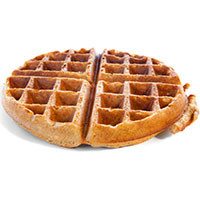
Belgian waffles have become the standard for most commercial operations due to their impressive size and deep pockets that hold toppings effectively. These oversized treats create an impressive presentation that immediately captures customer attention and provides excellent value for money.
The generous portions allow customers to customize with multiple toppings, creating a premium dining experience that justifies higher menu prices and increases customer satisfaction.
Commercial Characteristics:
- Large 7-8 inch diameter creates generous portions
- Deep pockets (1/4 inch or more) hold sauces and toppings
- Light, crispy exterior with soft interior
- Popular with customers for customization options
Best Restaurant Applications:
- Full-service breakfast restaurants
- Brunch menus requiring substantial portions
- Dessert stations with elaborate presentations
Brussels Waffles: Traditional European Style
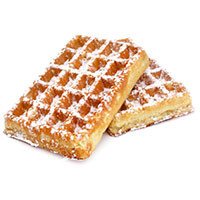
Brussels waffles, also known as Brussels-style, offer a more refined texture with smaller, more delicate pockets. These elegant treats embody the sophistication of European cafe culture, featuring a lighter batter that creates intricate patterns and subtle flavors.
The delicate construction makes them perfect for afternoon tea service or upscale brunch offerings, where presentation and refinement are paramount. Their smaller size allows for artistic plating arrangements and creates an intimate dining experience that appeals to discerning customers seeking authentic European flavors.
Commercial Characteristics:
- Smaller 6-7 inch diameter
- Shallower pockets perfect for powdered sugar and light toppings
- Lighter, more delicate texture
- Traditional European appearance
Best Restaurant Applications:
- Upscale cafes and bistros
- European-style breakfast menus
- Fine dining dessert presentations
Standard Waffles: Quick-Service Friendly
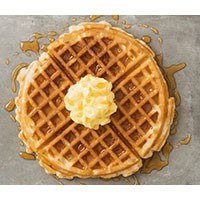
Standard waffles, also known as American-style waffles, feature a different grid pattern and cooking approach that works well in fast-paced environments. These reliable performers excel in high-volume operations where speed and consistency are critical.
The straightforward design and predictable cooking times make them ideal for busy breakfast rushes and family-style dining, where customers expect familiar comfort food without complex preparations. Their dense texture holds up well to heavy toppings and syrups, making them perfect for traditional American breakfast presentations that focus on hearty portions and familiar flavors.
Commercial Characteristics:
- Square or rectangular shape
- Shallower pockets designed for syrup and butter
- Dense, cake-like texture
- Quick cooking times
Best Restaurant Applications:
- Quick-service restaurants
- Family-style dining establishments
- Buffet operations requiring speed
Liege Waffles: Premium Dessert Option

Liege waffles offer a unique caramelized exterior that creates a distinctive presentation and flavor profile. These artisanal treats feature pearl sugar that caramelizes during cooking, creating a crispy, golden crust with molten sugar pockets that provide an extraordinary textural contrast.
The brioche-style dough and longer preparation time result in a premium product that commands higher menu prices and attracts dessert enthusiasts. Their irregular, rustic appearance adds visual interest to dessert displays and creates a memorable experience that customers associate with quality and craftsmanship.
Commercial Characteristics:
- Irregular shape with caramelized pearl sugar coating
- Rich, brioche-like dough
- Premium appearance and taste
- Longer preparation time but higher perceived value
Best Restaurant Applications:
- Premium dessert menus
- Upscale brunch services
- Specialty waffle shops
Bubble Waffles: Modern Trend Option
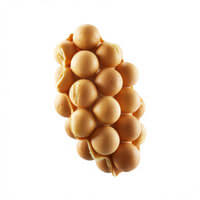
Bubble waffles, also known as egg waffles, offer a unique, trendy alternative with their distinctive honeycomb texture and versatility. These innovative treats feature a spherical mold that creates dozens of small, crispy bubbles, each containing tender, custard-like batter that melts in your mouth.
The egg-enriched dough provides rich flavor and golden coloring that appeals to modern customers seeking Instagrammable food experiences. Their playful appearance and ability to hold creative toppings make them perfect for trendy dessert menus, late-night service, and food truck operations looking to stand out in competitive markets.
Commercial Characteristics:
- Hexagonal grid pattern creating large air pockets
- Crispy exterior with soft, pancake-like interior
- Egg-based batter for rich flavor
- Popular for customization with various toppings
Best Restaurant Applications:
- Trendy cafes and dessert bars
- Food trucks and street food operations
- Asian-inspired menu offerings
- Late-night dessert service
Waffle Cones: Ice Cream Enhancement
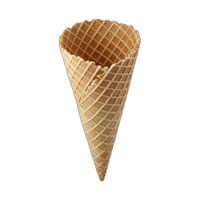
Waffle cones provide fresh, crisp vessels for ice cream and other frozen desserts, enhancing the overall customer experience. These freshly baked treats offer superior texture and aroma compared to pre-made cones, creating an authentic ice cream shop experience that builds customer loyalty.
The ability to customize cone shapes and add premium ingredients like nuts or chocolate creates upsell opportunities and differentiates your operation from competitors using mass-produced cones. Fresh waffle cones also eliminate waste from stale inventory and provide that irresistible warm-from-the-oven appeal that makes ice cream service more memorable.
Commercial Characteristics:
- Extremely shallow grids for thin, crisp cones
- Quick production for high-demand periods
- Customizable shapes and sizes
- Non-stick surfaces for easy release
Best Restaurant Applications:
- Ice cream shops and frozen dessert operations
- Concession stands and seasonal events
- Bakery dessert programs
- Catering services with dessert components
Waffle Maker vs. Waffle Iron: Choosing the Right Equipment
When selecting waffle equipment, you'll encounter both waffle makers and waffle irons. Understanding the differences helps you choose the best option for your operation.
Electric Waffle Makers
Commercial Advantages:
- Countertop convenience with built-in heating elements
- Consistent temperature control and programmable settings
- Digital timers and audio alerts for perfect results
- Easy cleanup with non-stick surfaces
Best For:
- Modern restaurant kitchens with limited space
- High-volume operations requiring speed and consistency
- Establishments prioritizing ease of use and reliability
Traditional Waffle Irons
Commercial Advantages:
- Durable construction with cast iron or steel plates
- Excellent heat retention and distribution
- Long lifespan with proper maintenance
- Often more affordable initial investment
Best For:
- Traditional or artisanal restaurant concepts
- Operations with experienced staff
- Budget-conscious establishments
- Specialty waffle operations requiring precise heat control
Key Differences
Power Source:
- Waffle Makers: Electric countertop appliances
- Waffle Irons: Stovetop heating (gas or electric)
Temperature Control:
- Waffle Makers: Built-in thermostats and digital controls
- Waffle Irons: Manual heat adjustment based on burner settings
Maintenance:
- Waffle Makers: Easier cleaning with modern surfaces
- Waffle Irons: Require seasoning and careful maintenance
Consistency:
- Waffle Makers: More consistent results for high-volume service
- Waffle Irons: Results depend on operator skill and experience
Temperature Requirements for Perfect Waffles
Temperature control is critical for consistent waffle quality. Different waffle types require specific cooking conditions to achieve optimal texture and appearance.
| Waffle Type: | Cooking Temperature: | Cooking Time: | Key Considerations: |
| Belgian | 360-380°F | 3-4 minutes | Higher heat creates crispy exterior |
| Brussels | 340-360°F | 3-4 minutes | Medium heat preserves delicate texture |
| Standard | 380-400°F | 2-3 minutes | Higher heat for dense, cake-like texture |
| Liege | 360-375°F | 4-5 minutes | Careful timing for proper caramelization |
| Bubble | 350-370°F | 3-4 minutes | Medium heat for honeycomb texture |
| Waffle Cones | 375-400°F | 2-3 minutes | High heat for crisp, thin cones |
Temperature Management Tips:
Maintaining consistent temperatures ensures every waffle meets your quality standards. Modern commercial waffle makers feature digital controls that hold temperatures within 5-10 degrees, preventing the quality variations that can occur with manual controls.
Commercial Waffle Maker Categories
The commercial waffle maker market offers several equipment types designed for different operational needs and production volumes.
Single Waffle Makers: Quality Focus
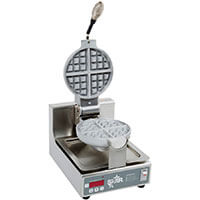
Single waffle makers produce one waffle at a time, allowing operators to focus on quality and presentation. These precision instruments excel in upscale environments where craftsmanship and attention to detail are paramount.
The focused production allows skilled operators to monitor each waffle individually, ensuring perfect timing, ideal browning, and artistic presentation that justifies premium pricing. While they may have lower throughput than double models, their ability to produce consistently exceptional results makes them invaluable for high-end cafes, fine dining establishments, and operations where quality reputation drives customer loyalty and repeat business.
Commercial Advantages:
- Precise temperature control for consistent results
- Easier to manage in limited kitchen space
- Better suited for premium, made-to-order service
- Lower initial investment costs
Best For:
- Upscale restaurants emphasizing quality over quantity
- Small cafes with limited counter space
- Operations where customization is key
Double Waffle Makers: Production Efficiency
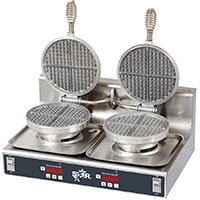
Double waffle makers feature two cooking surfaces, allowing simultaneous production of multiple waffles. These workhorses are engineered for high-volume operations where speed and efficiency are critical to success.
The dual cooking surfaces can produce up to twice the output of single models, making them essential for busy breakfast restaurants, buffet operations, and catering companies that need to serve large numbers of customers quickly. Despite their increased capacity, modern double models maintain excellent temperature consistency across both surfaces, ensuring that every waffle meets your quality standards even during peak demand periods.
Commercial Advantages:
- Doubles production capacity without additional labor
- Efficient use of counter space
- Consistent output for busy breakfast rushes
- Higher return on investment for volume operations
Best For:
- High-volume breakfast restaurants
- Buffet-style operations
- Catering companies requiring speed
- Large family-style restaurants
Production Capacity Considerations
Low Volume Operations (Under 50 waffles/day):
Single waffle makers provide the quality control needed for premium service without over-investing in capacity.
Medium Volume Operations (50-200 waffles/day):
Double waffle makers offer the perfect balance of quality and efficiency for most restaurant applications.
High Volume Operations (200+ waffles/day):
Multiple double waffle makers or specialized production equipment may be necessary for very busy operations.
Grid Material Selection for Commercial Use
The cooking surface material significantly impacts performance, maintenance requirements, and waffle quality.
Cast Aluminum: Popular Commercial Choice
Cast aluminum grids offer excellent heat distribution and are the most common choice for commercial waffle makers.
Commercial Benefits:
- Excellent heat conductivity for even cooking
- Durable construction withstands heavy use
- Most affordable option for quality equipment
- Compatible with both coated and non-stick surfaces
Maintenance Considerations:
- Requires regular seasoning for non-stick performance
- Hand washing recommended to preserve surface
- Occasional resurfacing may be needed with heavy use
Cast Iron: Traditional Durability
Cast iron grids provide exceptional heat retention and develop a natural non-stick surface over time.
Commercial Benefits:
- Superior heat retention for consistent results
- Develops natural non-stick properties with seasoning
- Extremely durable for high-volume operations
- Classic appearance preferred by some chefs
Maintenance Considerations:
- Requires proper seasoning and care
- Heavier weight may affect portability
- Longer preheat times required
Non-Stick Coated Surfaces: Modern Convenience
Modern waffle makers often feature non-stick coatings for easier maintenance and improved performance.
Commercial Benefits:
- Easy cleanup and maintenance
- Consistent release of waffles
- Reduced need for additional fats or oils
- Modern appearance and performance
Maintenance Considerations:
- Coating may wear over time with heavy use
- Avoid metal utensils to preserve surface
- Regular inspection for coating integrity
Electrical Configuration and Installation
Commercial waffle makers require careful consideration of electrical requirements to ensure safe and efficient operation.
Voltage and Power Requirements
Standard Commercial Specifications:
- 120V models for most restaurant applications
- 15-20 amp circuits typically required
- 1800-2000 watts for single waffle makers
- 3000-3600 watts for double waffle makers
Installation Considerations:
- Dedicated circuits prevent power fluctuations
- Adequate ventilation for heat dissipation
- Stable, level surfaces for optimal performance
- Clearance requirements for safe operation
Power Configuration Options
Corded Models:
- Standard plug-and-play installation
- Flexible placement options
- Suitable for most restaurant environments
- Easier to relocate if needed
Hardwired Models:
- Direct electrical connection
- Higher power capacity for heavy-duty use
- Preferred for high-volume operations
- More permanent installation requirement
Business Applications and Menu Integration
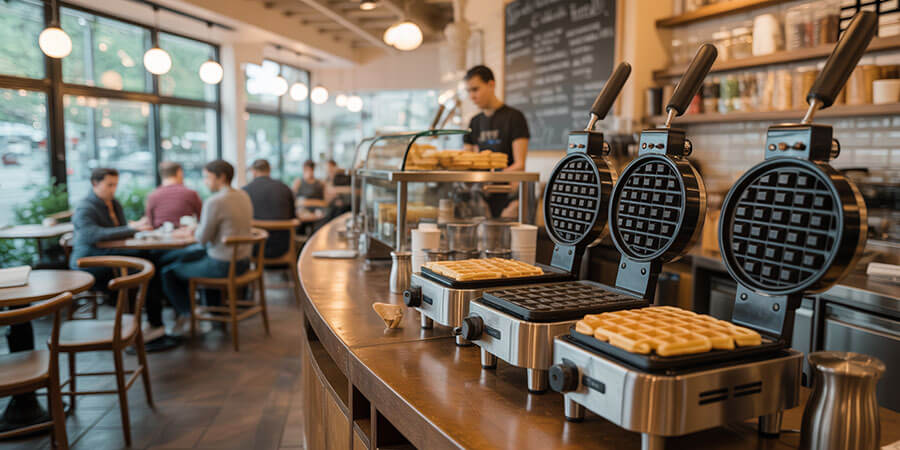
Successful waffle programs require thoughtful integration into your overall restaurant concept and operations.
Breakfast Service Optimization
Morning Rush Management:
Position waffle stations near the front of the kitchen for quick access during peak breakfast hours. Train staff on efficient batter preparation and timing to maintain steady output during busy periods.
Menu Engineering:
Create waffle-centric menu items that complement your existing offerings. Consider waffle sandwiches, waffle-based benedicts, or waffle bowls as unique menu additions.
Dessert Program Enhancement
Premium Dessert Creations:
Use high-quality waffle makers to create signature dessert items. Belgian waffles with fresh berries, Liege waffles with artisanal toppings, and creative waffle sundaes can command premium pricing.
Cross-Merchandising Opportunities:
Pair waffle service with complementary items like specialty coffees, fresh fruit platters, and premium syrups to increase check averages.
Catering and Special Events
Mobile Waffle Stations:
Compact commercial waffle makers work well for off-site catering. Look for models with carrying handles and cord storage for easy transport.
Event-Specific Menus:
Create themed waffle offerings for weddings, corporate events, and festivals. Custom toppings and presentations can create memorable experiences.
Cost Analysis and ROI Considerations
Investing in commercial waffle equipment requires understanding both upfront costs and long-term profitability.
Investment Ranges by Equipment Type
| Equipment Type: | Entry Level: | Mid-Range: | Premium: |
| Single Waffle Maker | $800-$1,500 | $1,500-$2,500 | $2,500-$4,000+ |
| Double Waffle Maker | $1,200-$2,500 | $2,500-$4,000 | $4,000-$6,500+ |
| Specialty Models | $2,000-$3,500 | $3,500-$5,500 | $5,500-$8,000+ |
Operating Cost Factors
Energy Consumption:
- Typical usage: 1.8-3.6 kWh per hour
- Cost impact: $0.20-$0.50 per hour of operation
- Consider energy-efficient models for high-volume use
Maintenance Expenses:
- Annual servicing: $100-$300
- Grid resurfacing: $50-$150 every 1-2 years
- Cleaning supplies: $20-$50 monthly
Revenue Projections and Break-Even Analysis
Daily Revenue Potential:
- Casual restaurant: $150-$300 from waffle sales
- Breakfast-focused cafe: $300-$600 from waffle sales
- High-volume operation: $500-$1,000+ from waffle sales
Profit Margin Analysis:
- Food cost: 25-35% of menu price
- Labor cost: 15-25% of revenue
- Net profit margin: 40-60% on waffle sales
Break-Even Calculation Example:
- Equipment cost: $2,500
- Daily revenue: $200
- Daily profit: $80 (40% margin)
- Payback period: Approximately 31 days
Equipment Selection Guide by Business Type
🍳 For Breakfast-Focused Restaurants
Recommended Equipment: Double Belgian waffle maker
Key Priorities: Speed, consistency, high-volume production
Additional Features: Timer systems, temperature controls
Staff Training Focus: Production efficiency and quality control
☕ For Upscale Cafes and Bistros
Recommended Equipment: Single premium waffle maker
Key Priorities: Quality, presentation, customization
Additional Features: Precise temperature control, quality construction
Staff Training Focus: Artisan techniques and presentation
🏃 For Quick-Service Operations
Recommended Equipment: Double waffle maker with rapid recovery
Key Priorities: Speed, reliability, ease of cleaning
Additional Features: Quick preheat, durable construction
Staff Training Focus: Efficiency and consistency
🎪 For Catering Companies
Recommended Equipment: Portable double waffle maker
Key Priorities: Mobility, quick setup, reliability
Additional Features: Carrying handles, cord storage
Staff Training Focus: Setup efficiency and off-site operations
Essential Accessories and Supplies
Batter Preparation Equipment
- Commercial mixers for consistent batter quality
- Storage containers with temperature control
- Batter dispensers for portion control
- Measuring tools for recipe consistency
Service and Presentation Items
- Commercial waffle tongs and spatulas
- Warming trays to maintain serving temperature
- Garnish stations for toppings and accompaniments
- Disposable service items for quick cleanup
Maintenance and Safety Supplies
- Food-safe cleaning solutions
- Grill cleaning brushes and pads
- Temperature monitoring tools
- Safety equipment for hot surface handling
Maintenance and Best Practices
Daily Cleaning Procedures
Post-Service Cleaning:
- Allow grids to cool completely before cleaning
- Remove excess batter and crumbs
- Use appropriate cleaning solutions for your grid material
- Dry thoroughly to prevent rust and maintain non-stick properties
Weekly Maintenance Tasks
Deep Cleaning:
- Disassemble removable parts for thorough cleaning
- Inspect grids for wear or damage
- Clean grease traps and ventilation areas
- Test all safety features and controls
Preventative Maintenance Schedule
Monthly Inspections:
- Check electrical connections and cords
- Calibrate temperature controls
- Inspect grids for even heating
- Test timer accuracy
Annual Professional Service:
- Complete equipment inspection
- Grid resurfacing if needed
- Electrical system testing
- Performance optimization
Essential Waffle Maker Accessories
Professional waffle service requires the right supporting tools and accessories to ensure efficiency, consistency, and quality.
Batter Management Tools
Batter Dispensers:
- Ensure consistent portion sizes
- Reduce waste and mess
- Speed up service during busy periods
- Available in various sizes for different waffle types
Batter Cups:
- Marked measurements for consistent results
- Easy to clean and sanitize
- Stackable for efficient storage
- Essential for quality control
Cleaning and Maintenance Supplies
Specialized Cleaning Brushes:
- Designed for waffle maker grid patterns
- Remove batter residue without damaging surfaces
- Heat-resistant materials for safe use
- Extend equipment lifespan
Drip Trays:
- Catch excess batter and drips
- Maintain clean counter surfaces
- Easy to empty and clean
- Prevent slips and safety hazards
Service and Presentation Items
Waffle Tongs:
- Specialized grips for different waffle types
- Prevent crushing delicate waffles
- Insulated handles for safety
- Various sizes for different applications
Warming Trays:
- Keep waffles crisp until service
- Maintain optimal serving temperatures
- Stackable for space efficiency
- Essential for high-volume operations
Future Expansion Opportunities
As your waffle program grows, consider these specialized equipment options to expand your offerings:
- Specialty Waffle Shapes: Heart-shaped or custom waffle makers for themed events
- Industrial Production Lines: High-capacity equipment for large-scale operations
- Mobile Waffle Stations: Portable equipment for catering and special events
- Automated Batter Systems: Consistent mixing and portioning for quality control
Explore our complete line of commercial waffle equipment to find the perfect solution for your business needs.
Frequently Asked Questions
What's the difference between Belgian and American waffles?
Belgian waffles feature a lighter, crispier texture with deeper pockets for holding toppings, while American waffles have a denser, cake-like texture with shallower pockets designed primarily for syrup.
How often should I clean my commercial waffle maker?
Daily cleaning is essential for food safety and performance. Wipe down surfaces after each use, perform deep cleaning weekly, and schedule professional maintenance annually.
Can I make different types of waffles on the same machine?
Most commercial waffle makers can accommodate different waffle types, but you'll need to adjust temperature settings and cooking times. Some models offer programmable settings for different waffle styles.
What's the most important feature for a commercial waffle maker?
Consistent temperature control is the most critical feature. Look for models with digital controls and even heat distribution to ensure every waffle meets your quality standards.
How do I calculate the right size waffle maker for my business?
Consider your peak hour demand and desired service speed. A busy breakfast restaurant might need double waffle makers, while a small cafe could manage with a single unit.
Shop Commercial Waffle Makers
Ready to add profitable waffle offerings to your menu? Browse our complete selection of commercial waffle makers and related equipment:
- [Commercial Waffle Makers] Professional-grade equipment for consistent results
- [Waffle Cone Makers] Essential equipment for ice cream operations
- [Commercial Mixers] Quality batter preparation equipment
- [Waffle Accessories] Everything you need for successful waffle service
Need help choosing the right waffle maker for your business? Contact our foodservice specialists for personalized recommendations based on your menu, space, and production requirements.
This comprehensive guide provides everything you need to know about selecting and operating commercial waffle makers for your restaurant or food service business. Whether you're starting a waffle program or upgrading your existing equipment, the right waffle maker can significantly impact your profitability and customer satisfaction.
Share This!